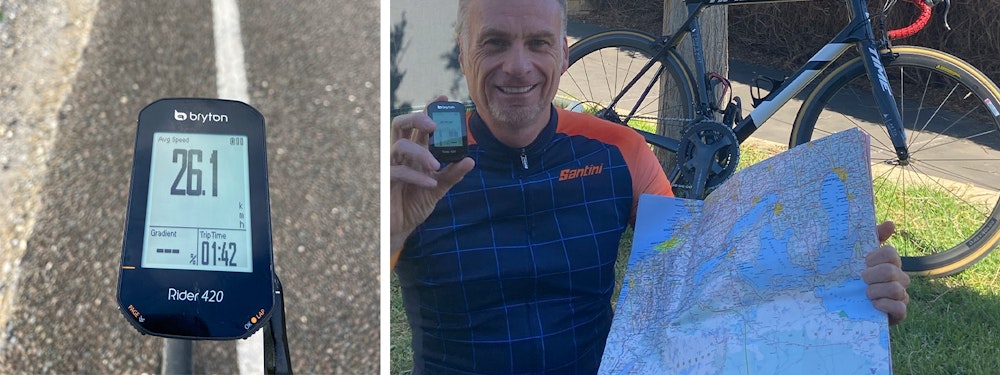Today we are taking the Bryton Rider 420 through its paces.
I always get excited trying a new GPS. During winter I normally work as a guide showing people around the Tour de France and Tour of Italy, so a good GPS unit is the most important piece of equipment.
You know, it’s funny. It doesn’t seem that long ago while guiding cyclists around Europe that I was using a map. Yes, a paper Michelin map was our only tool that we had available to us during the early 2000s, before GPS units specifically for cycling were introduced a little later around 2006-07. Since then, I have pretty much used all GPS units available and we have come a long way since the early days of robust units with a short battery life.

My first impression of the Bryton Rider 420 is that it’s lightweight at 68grams, but the screen is large enough with 2.3inch display, to clearly see up to 8 data fields per page.
Now as a guide, battery life is important as we can easily spend up to 10 hours riding up and down the Alpine mountain passes of France. While I’m not in France at the moment, but my longest ride with the 420 in Adelaide was still a 9 hour ride around the Flinders Ranges. The Battery life was still way over 50%. This gives me confidence that when fully charged, the 420 unit will give you well over 30 hours of use - which is handy during those 24 hour Enduro events, or if you get really lost (which you won’t because you have your route already uploaded onto your 420!)
Today most of us have Cadence and power metres. Thanks to Bryton's ease of connectivity, Bluetooth & Ant+ pairing my device with external components was a breeze - I was strapping on my helmet ready to ride in no time.
Personally I really love the Bryton active app. It’s free via the App Store and a must have when using the unit. You can customise all your data fields and functions (77+). If you're planning to load a riding route onto your 420 this can be done on the App, or via a 3rd party app such as Strava - or Ride with GPS etc. - Most will easily sync onto your unit.
Speaking from experience, it can take a while for a GPS unit to connect to a satellite. Surprisingly it only took a minute or so for the 420 to find a satellite. Bryton use 5 satellites. I had to go to the Bryton website for this part. Bryton uses the Glonass (Russia), BDS(China), Galileo(Europe) & QZSS (Japan) satellites so this explains its ease when connecting to a satellite. I noticed that even while riding through the gorges of the Flinders ranges, the GPS kept a strong signal. This is comforting to know as we plan on riding through the mountains of Italy sometime in the future. My bike is now complete for when the world is open again!
Now, my eyesight isn’t what it used to be, so I was really happy with the crystal clear clarity of the screen - even in strong sunlight the LCD (black and white) screen was clear enough for me to read and during the darker hours of the morning ride the backlight worked a treat.
After a few weeks of using the Rider 420 I have no complaints. Some other details worth mentioning are that it fits easily into the mount it comes with and even over rough terrain I never had the feeling it might fall out. Overall, this little GPS unit gets a 5-star rating from me and I’ll find a nice little spot for her next to all my other GPS devices.
Now, this blog isn’t meant to be a product review even though it may seem so. This has simply been my experience so far with the Rider 420. What was most amazing was its price, RRP of $220.00. I can confidently say from my experience it’s the best value for money GPS unit at your local bike shop, or on the broader cycling market.





